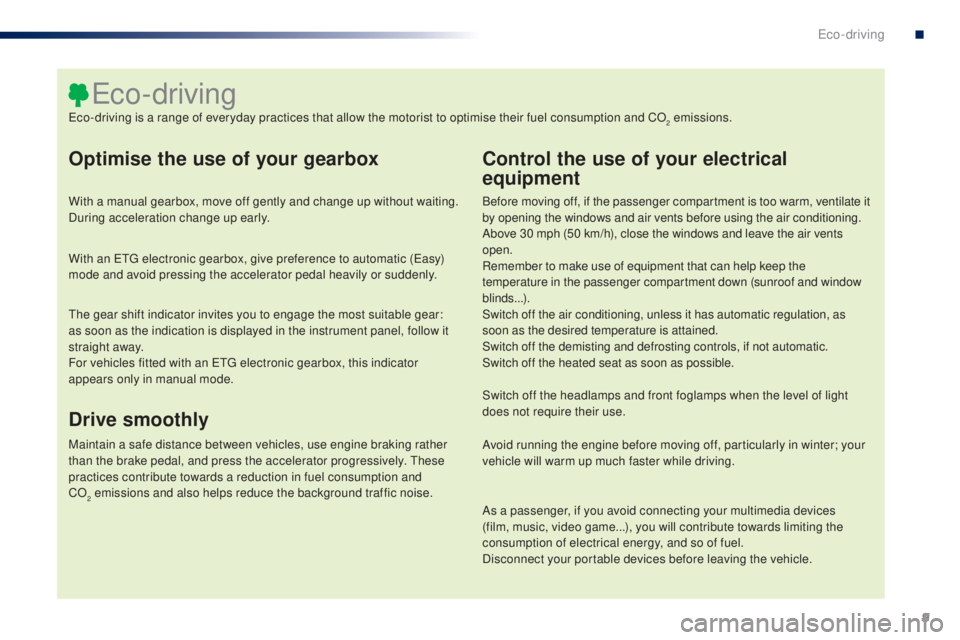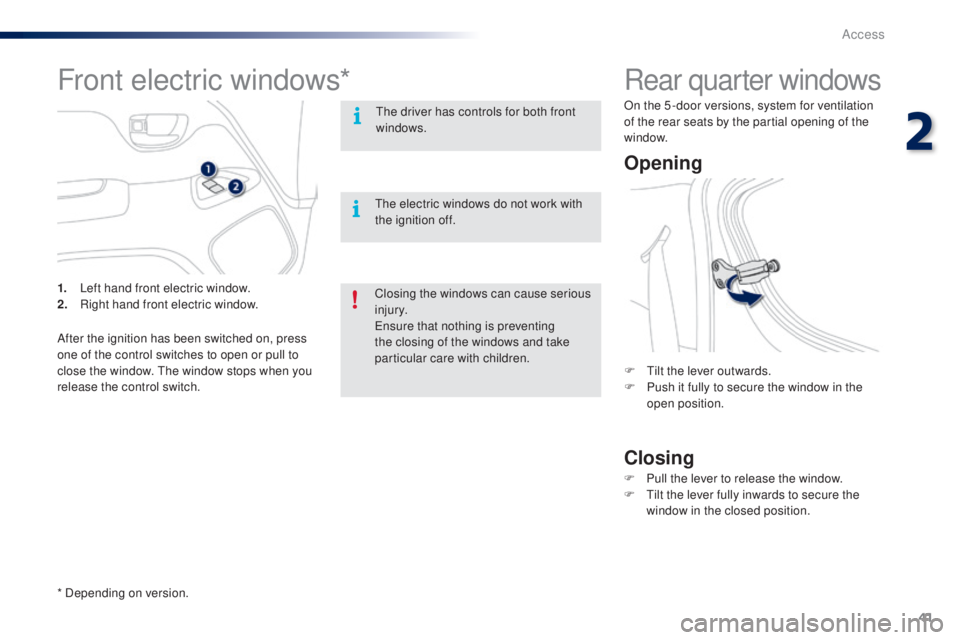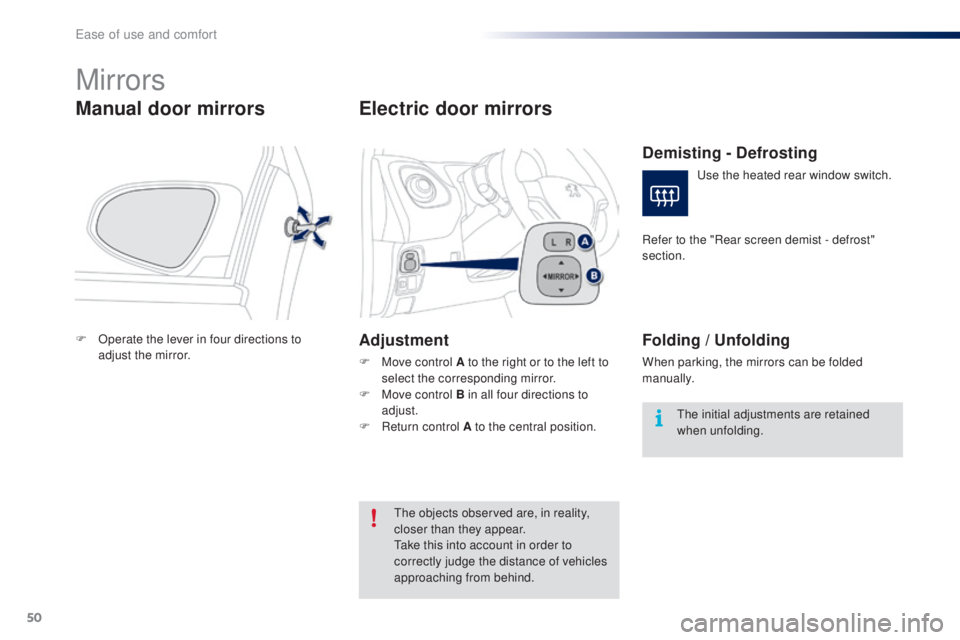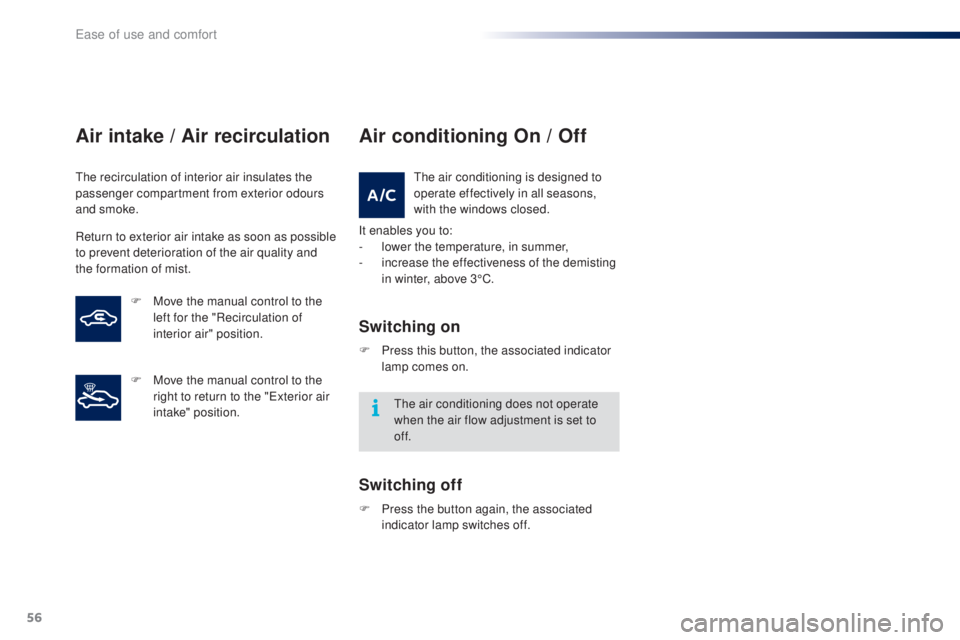2016 PEUGEOT 108 window
[x] Cancel search: windowPage 4 of 268

.
.
108_en_Chap00a_sommaire_ed01-2016
Instrument panels 11
Display screens
1
3
Indicator and warning lamps
1
5
Indicators
26
tr
ip computer
2
7
Setting the time
2
9
InstrumentsOver view
Keys
31
Keyless e
n
try and Starting system
3
4
Doors
38
Boot
39
Front electric windows
4
1
Rear quarter windows
4
1
ele
ctric fabric roof
4
2
Access
Front seats 4 6
Rear seats
4
8
Mirrors
50
Steering wheel adjustment
5
1
Ventilation
52
Heating
54
Manual air conditioning
5
5
Automatic air conditioning
5
7
Front demist - defrost
6
0
Rear screen demist - defrost
6
1
Courtesy lamp
6
2
Boot lamp
6
2
Interior fittings
6
3
Rear parcel shelf
6
7
Boot fittings
6
8
ease of use and comfort
Driving recommendations 70
Starting - switching off the engine
with the key
7
1
Starting - switching off the engine with
the
Keyless e
n
try and Starting system
7
2
Manual parking brake
7
6
5-speed manual gearbox
7
6
e
tg
el
ectronic gearbox
7
7
ge
ar shift indicator
8
1
Hill start assist
8
2
Stop & Start
8
3
Speed limiter
8
6
Reversing camera
9
2
Lane departure warning system
9
3
Under-inflation detection
9
5
Driving
e
co-driving
Contents
Page 6 of 268

4
108_en_Chap00b_vue-ensemble_ed01-2016
Keys 31
Remote control 3 2-33
"Keyless
e
n
try and Starting"
system
34-37
Remote control battery
3
3, 37
Starting
7
1, 72-73
exterior
Door mirrors 5 0
Lighting control stalk
9
8 -103
Adjusting the headlamps
1
03
Changing bulbs
1
63-165, 167
-
f
ront lamps
-
d
irection indicator repeaters
Doors
38-40
-
ope
ning / closing
-
c
entral locking
el
ectric windows
4
1
Quarter lights (5 -door)
4
1 Wipers
10
4 -105
Changing a wiper blade
1
44
Boot 39-40te
mporary puncture
repair kit
1
53-157
Reversing camera
9
2
to
w i n g
18 0
Changing bulbs
1
66-167
-
r
ear lamps
-
3
rd brake lamp
-
n
umber plate lamps
Fuel tank, ref uelling
13 8 -13 9
Fuel gauge
26
ele
ctronic stability
programme
107-109
Snow chains
1
40
un
der-inflation detection
9
5-97
ty
re pressures
1
56 -157, 184
Changing a wheel
1
58-162
-
tools
-
r
emoval / fitting
ele
ctric fabric roof
4
2-45
Roof bars
1
44
Accessories
1
42-143
Over view
Page 8 of 268

6
108_en_Chap00b_vue-ensemble_ed01-2016
Dashboard fuses 168-172
Instruments and controls
Door mirrors 5 0el
ectric windows 4 1Courtesy lamp
6
2
Control for electric fabric roof
4
2
Rear view mirror
5
1
Sun visors
6
4
Manual parking brake
7
6Heating, ventilation
5
2-54
Manual air conditioning
5
5-56
Automatic air conditioning
5
7-59
Windscreen demist / defrost
6
0
Rear screen demist / defrost
61
7-inch touch screen
1
85 -234
Radio
235-254
Setting the time
2
9, 30
Manual gearbox
7
6
e
tg
el
ectronic gearbox
7
7-80
ge
ar shift indicator
8
1
Hill start assist
8
2
12 V accessory socket
6
4
uS
B port
6
5
Jack auxiliary socket
6
5
Instrument panel
1
1-12
Rev counter
1
2
Central screen
1
3
Indicator and warning lamps
1
5-25
Indicators 26
tr
ip computer
2
7-28
Side air vents
5
2
Passenger's front airbag
1
19
gl
ove box
6
4
Deactivating the passenger's front airbag
119
Reinitialising the under-inflation detection 96-97
Over view
Page 11 of 268

9
108_en_Chap00c_eco-conduite_ed01-2016
optimise the use of your gearbox
With a manual gearbox, move off gently and change up without waiting.
During acceleration change up early.
With an etg electronic gearbox, give preference to automatic (
ea
sy)
mode and avoid pressing the accelerator pedal heavily or suddenly.
Control the use of your electrical
equipment
Before moving off, if the passenger compartment is too warm, ventilate it
by opening the windows and air vents before using the air conditioning.
Above 30 mph (50 km/h), close the windows and leave the air vents
open.
Remember to make use of equipment that can help keep the
temperature in the passenger compartment down (sunroof and window
blinds...).
Switch off the air conditioning, unless it has automatic regulation, as
soon as the desired temperature is attained.
Switch off the demisting and defrosting controls, if not automatic.
Switch off the heated seat as soon as possible.
Switch off the headlamps and front foglamps when the level of light
does not require their use.
Avoid running the engine before moving off, particularly in winter; your
vehicle will warm up much faster while driving.
As a passenger, if you avoid connecting your multimedia devices
(film, music, video game...), you will contribute towards limiting the
consumption of electrical energy, and so of fuel.
Disconnect your portable devices before leaving the vehicle.
eco-driving
eco-driving is a range of everyday practices that allow the motorist to optimise their fuel consumption and CO2 emissions.
th
e gear shift indicator invites you to engage the most suitable gear:
as soon as the indication is displayed in the instrument panel, follow it
straight away.
For vehicles fitted with an
etg
electronic gearbox, this indicator
appears only in manual mode.
Drive smoothly
Maintain a safe distance between vehicles, use engine braking rather
than the brake pedal, and press the accelerator progressively. th ese
practices contribute towards a reduction in fuel consumption and
CO
2 emissions and also helps reduce the background traffic noise.
.
eco-driving
Page 30 of 268

28
With the touch screen
From the Menu page in the touch screen:
F Sel ect the " Vehicle information " tab.
th
e "
tr
ip information " window is displayed
with the following information:
-
"Average speed ",
-
"
ela
psed time ",
-
"Range ",
-
t
he current fuel consumption, presented in
graphical form.
th
e "
er
ase" button resets the fuel consumption
data in the touch screen and the instrument
panel. If your vehicle has a touch screen, you can
view information on the current journey.
trip computer, a few definitions
Range
(miles or km)th e distance which can still be travelled with
the fuel remaining in the tank (related to the
average fuel consumption over the last few
miles (kilometres) travelled).
th
is value may vary following a change
in the style of driving or the relief,
resulting in a significant change in the
current fuel consumption.
When the fuel level is low, the message
"Lo
F
u
e
L
" is displayed.
If only a small amount of fuel is added, the
range may not be recalculated.
Current fuel consumption
(mpg or l/100 km or km/l)
Calculated over the last few seconds.
Stop & Start time counter
(minutes / seconds or hours / minutes)
If your vehicle is fitted with Stop & Start,
a
time counter calculates the time spent in
S
tO
P mode during a journey.
It resets to zero every time the ignition is
switched on.
Average fuel consumption
(mpg or l/100 km or km/l)
Calculated since the last trip computer reset.
Average speed
(mph or km/h)
Calculated since the last trip computer reset.
Instruments
Page 43 of 268

41
108_en_Chap02_ouvertures_ed01-2016
Rear quarter windows
opening
Closing
F tilt the lever outwards.
F P ush it fully to secure the window in the
open position.
F
P
ull the lever to release the window.
F
t
i
lt the lever fully inwards to secure the
window in the closed position.
On the 5 -door versions, system for ventilation
of the rear seats by the partial opening of the
window.
Front electric windows*
the driver has controls for both front
windows.
th
e electric windows do not work with
the ignition off.
1.
L
eft hand front electric window.
2.
R
ight hand front electric window.
After the ignition has been switched on, press
one of the control switches to open or pull to
close the window.
t
he
window stops when you
release the control switch.
* Depending on version. Closing the windows can cause serious
injury.
en
sure that nothing is preventing
the closing of the windows and take
particular care with children.
2
Access
Page 52 of 268

50
108_en_Chap03_ergonomie-confort_ed01-2016
Mirrors
Manual door mirrors
F Operate the lever in four directions to adjust the mirror.
electric door mirrors
Adjustment
F Move control A to the right or to the left to select the corresponding mirror.
F
M
ove control B in all four directions to
adjust.
F
R
eturn control A to the central position.
th
e objects observed are, in reality,
closer than they appear.
ta
ke this into account in order to
correctly judge the distance of vehicles
approaching from behind.
Demisting - Defrosting
use the heated rear window switch.
Refer to the "Rear screen demist - defrost"
section.
Folding / un folding
When parking, the mirrors can be folded
manually.
th
e initial adjustments are retained
when unfolding.
ease of use and comfort
Page 58 of 268

56
108_en_Chap03_ergonomie-confort_ed01-2016
Air intake / Air recirculation
the recirculation of interior air insulates the
passenger compartment from exterior odours
and smoke.
Return to exterior air intake as soon as possible
to prevent deterioration of the air quality and
the formation of mist.
Air conditioning on / of f
the air conditioning is designed to
operate effectively in all seasons,
with the windows closed.
It enables you to:
-
l
ower the temperature, in summer,
-
i
ncrease the effectiveness of the demisting
in winter, above 3°C.
Switching on
F Press this button, the associated indicator lamp comes on.
th
e air conditioning does not operate
when the air flow adjustment is set to
of f.
Switching off
F Press the button again, the associated indicator lamp switches off.
F
M
ove the manual control to the
left for the "Recirculation of
interior air" position.
F
M
ove the manual control to the
right to return to the "
ex
terior air
intake" position.
ease of use and comfort